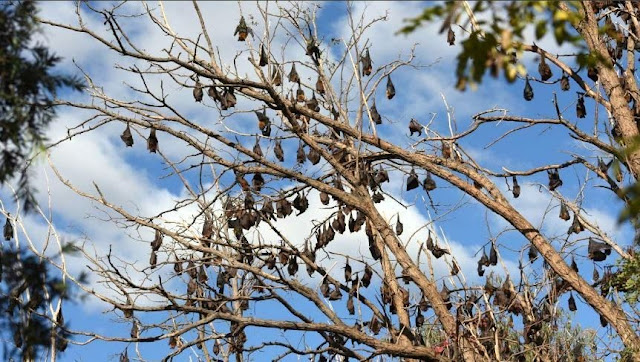Tamworth flying fox problem will need state government funding
FLYING FOX FIX: Ross Briggs (middle) with residents Brian Harris and Peter Brisk whose properties have been directly affected by roosting bats.
Photo: Peter Hardin
TAMWORTH’S two-year battle with flying foxes is coming to a critical point, but council is still calling for the state government to pay its fair share.
Tamworth Regional Council (TRC) finally endorsed a plan to manage bat colonies in town, after months of delays which sought further research and community feedback.
But the finish line is still in the distance, as council seeks a licence from the NSW Office of Environment and Heritage, which will allow them to bring the plan to fruition.
TRC will spend $3000 to bring in a consultant to help get their licence application over the line.
In the meantime, council will start spending part of the state government grant they received to roll out an “education program” about the native animals.
“It will include things like education programs, web-pages, social media campaigns, signage to educate the community,” regulatory services manager Ross Briggs said.
“What we want to do is dispel the myths, and in doing that reduce the amount of complaints back down to the actual impacts of the flying foxes.
Everything you need to know about flying foxes
“When we had the influx in 2015, a lot of the calls we had were around flying foxes are unsafe, they’re unclean, we’re going to catch rabies, we’re going to die.”
Mr Briggs said the program would cost $7000, with council providing “in-kind support” in the shape of the staff’s time.
Council’s grand plan to move the bats includes a number of proactive measures.
“That would be things like buffers around the residences that have flying foxes living directly above their houses, in their backyards or across the river,” Mr Briggs said.
“We would look to thin out the vegetation by taking out the weed species trees, so Locust trees and any of the non-native trees in that area.”
Mr Briggs estimated early on the plan could cost up to $200,000 to carry out and said it was important for the state government to come to the party with funding.
“It’s very important because local governments across NSW aren’t resourced for this sort of work,” he said.
“We don’t necessarily have staff that are experienced in it and we don’t have budgets that can cater for it.”
TAMWORTH’S two-year battle with flying foxes is coming to a critical point, but council is still calling for the state government to pay its fair share.
Tamworth Regional Council (TRC) finally endorsed a plan to manage bat colonies in town, after months of delays which sought further research and community feedback.
But the finish line is still in the distance, as council seeks a licence from the NSW Office of Environment and Heritage, which will allow them to bring the plan to fruition.
TRC will spend $3000 to bring in a consultant to help get their licence application over the line.
In the meantime, council will start spending part of the state government grant they received to roll out an “education program” about the native animals.
“It will include things like education programs, web-pages, social media campaigns, signage to educate the community,” regulatory services manager Ross Briggs said.
“What we want to do is dispel the myths, and in doing that reduce the amount of complaints back down to the actual impacts of the flying foxes.
Everything you need to know about flying foxes
“When we had the influx in 2015, a lot of the calls we had were around flying foxes are unsafe, they’re unclean, we’re going to catch rabies, we’re going to die.”
Mr Briggs said the program would cost $7000, with council providing “in-kind support” in the shape of the staff’s time.
Council’s grand plan to move the bats includes a number of proactive measures.
“That would be things like buffers around the residences that have flying foxes living directly above their houses, in their backyards or across the river,” Mr Briggs said.
“We would look to thin out the vegetation by taking out the weed species trees, so Locust trees and any of the non-native trees in that area.”
Mr Briggs estimated early on the plan could cost up to $200,000 to carry out and said it was important for the state government to come to the party with funding.
“It’s very important because local governments across NSW aren’t resourced for this sort of work,” he said.
“We don’t necessarily have staff that are experienced in it and we don’t have budgets that can cater for it.”
When council launches its grand plan depends on the approval of their licence.
“The next stage, when we get the licence, are the management actions that could have an impact of the flying foxes,” he said.
“The next stage, when we get the licence, are the management actions that could have an impact of the flying foxes,” he said.










sm done flipboard pinterest only
ReplyDelete